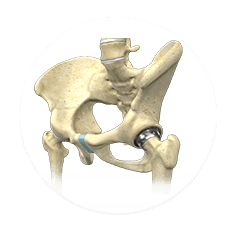Hip Replacement
The hip joint is one of the body's largest weight-bearing joints and is the point where the thigh bone (femur) and the pelvis (acetabulum) join. It is a ball and socket joint in which the head of the femur is the ball and the pelvic acetabulum forms the socket. The joint surface is covered by a smooth articular cartilage that cushions and enables smooth movements of the joint. Many injuries and diseases to the hip can cause pain and disability and may require hip replacement surgery. Hip replacement can involve a partial replacement where only those parts of the bone that are damaged are replaced with a prosthesis, or total replacement where the articulating regions of both the femur and acetabulum are replaced with prostheses.
Hip replacement surgery is indicated for degenerative hip disorders such as rheumatoid arthritis (RA) and osteoarthritis (OA), avascular necrosis, injury leading to the degeneration of the hip joint, autoimmune diseases that affect the joints (such as lupus) and when conservative hip treatments fails to provide relief.
Hip replacement surgery can be performed through the open approach or minimally invasively. The open approach involves performing the surgery through a large incision made on the hip, while the minimally invasive approach is performed through one or two smaller incisions and the use of a laparoscope, a narrow lighted tube with a camera attached. The laparoscope is inserted through one of the incisions and provides your surgeon with an enlarged and clear view of the surgical site on a TV monitor.
Hip replacement surgery is performed under general anesthesia. Once the incision(s) are made, the muscles are separated to expose the joint. The femur is dislocated from the acetabulum. The surface of the socket is cleaned and the arthritic bone is removed using a tool called a reamer. A metal or plastic acetabular implant is inserted into the socket and fixed using screws or special cement. The femur or thigh bone is then prepared by removing the arthritic bone using special instruments and shaped to exactly fit the new metal femoral component. The femoral stem is then inserted into the femur either by a press fit or using bone cement. Then the femoral head component made of metal or ceramic is placed on the femoral stem. All the new parts are secured in place. The muscles and tendons around the new joint are repaired and the incision is closed.
Depending on the surgical technique used, you will need to stay in the hospital for four to six days. You will be encouraged to start physical therapy the day after your procedure and gradually continue it for a few months. This will help in improving your range-of-motion and strengthening your muscles. When you go home, you will be instructed on certain activities that you would need to avoid, to aid in a complete and speedy recovery.
As with any surgical procedure, hip replacement may involve certain risks and complications such as infection, injury to nerves and blood vessels, formation of blood clots in the leg veins, implant malposition and fracture of the femur or pelvis.




